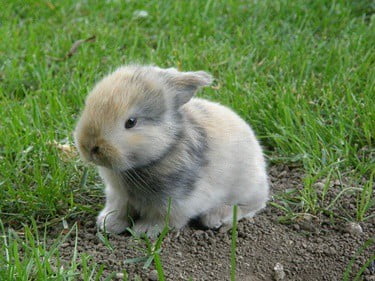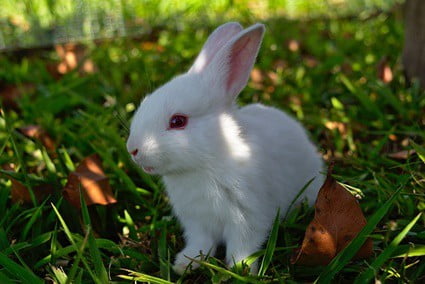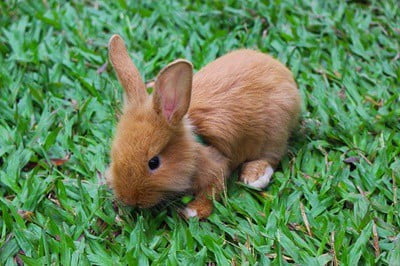Rabbits are naturally outdoor creatures, so you may wonder if it’s safe for your baby rabbit to be brought outside. Despite being domesticated, pet rabbits can certainly benefit from the fresh air, grass to munch on, and space to play in. However, it’s important to time your baby rabbit’s introduction to the great outdoors, so it isn’t harmed in any way.
Baby rabbits can be brought outdoors when they are four weeks old. However, they should never be left alone unsupervised. There are many dangers that can fall on your rabbit if it is left alone outside. These include poisonous plants, extreme temperatures, and predators such as cats, hawks, and snakes.
Nonetheless, taking your baby rabbit outside will benefit it. Your rabbit can enjoy the exercise, sunshine, and fresh air. In order to let your rabbit enjoy this safely, you should understand the best ways to protect it. This can include building a rabbit run and training your rabbit to wear a harness.
Are Baby Rabbits OK Outside?
The outdoors can be extremely dangerous for baby rabbits. After all, rabbits of this age are inexperienced in avoiding predators. Likewise, they can slip more easily through fences and escape into hazardous areas. Even if kept in one happy place, a baby rabbit is more susceptible to illness brought on by temperature changes.
Overall, this is the most at-risk time of your rabbit’s life, and it should be handled with care. However, this doesn’t mean that rabbits should never be allowed outside. On the contrary, being allowed outside can make your baby rabbit healthier and happier. Just be sure to guard its safety.
Rabbits should be supervised outdoors. Additionally, babies should only be allowed outside for a short period of time. As easily stressed creatures, too much exposure to the outdoors can exhaust or overstimulate them. Only keep your baby rabbit outside for a few hours at a time.
When Can Baby Rabbits Go On Grass?
Baby rabbits can go on grass as soon as four weeks old. At this age, they will be curious, eager to play, and can move around without help.
If a younger rabbit than four-weeks is placed outside, it may experience trouble navigating the area. Likewise, it will have a weaker immune system (more than a baby rabbit does already), which can make the outdoors harmful to it.
At the right age, your baby rabbit will love to explore its surroundings. Expect a bit of digging, burrowing, foraging, and jumping. All of these things are healthy for a rabbit, especially at this age. Just make sure you still have your pet bun in your vision at all times.

Other Surfaces
Grass is a great place for rabbits of all ages. It’s soft, is great for digging, and it’s also great for munching. But what about other materials found outdoors?
Most surfaces are safe for baby rabbits. However, that’s only true if it isn’t coated or treated with toxic chemicals, like those found in wood treatments or weed-killers. Overall, most materials that are safe for humans will also be safe for rabbits.
Keep an eye out for surfaces that can easily absorb heat. These include materials like plastics and concrete. As long as the surface isn’t too hot, your rabbit will be fine.
Can Baby Rabbits Live Outside?
You may wonder if your rabbit will be happier living in a more natural environment. Rabbits live outside in the wild, so shouldn’t your pet rabbit live outside too? This is a misconception. Rabbits shouldn’t be left outdoors unsupervised. Likewise, they definitely shouldn’t be kept outside full-time, especially if they’re babies.
This is because domestic rabbits are very different from wild rabbits. Your pet bun likely wasn’t captured in a nearby meadow, tamed, and then brought into your house. Instead, most domestic rabbits are bred to be pets and come from a long line of indoor rabbits. This has an effect on their behavior, physicality, and temperament.
A domestic rabbit will be less resistant to the elements, which can lead to freezing or heatstroke. Likewise, it won’t understand how to avoid predators like a wild rabbit. It relies on you for food, so should it escape the safety of its enclosure, it won’t be able to fend for itself.
This goes double for baby rabbits. As still-developing bunnies, they will be even more sensitive to dehydration, hypothermia, general sickness, and predators.
Should Pet Rabbits Only Live Inside?
Keeping your rabbits indoors can be healthier for your rabbits. Domestic rabbits used to have a lifespan of 6 to 8 years. When the House Rabbit Society introduced rabbits as indoor pets, the rabbit’s lifespan suddenly rocketed. Currently, a rabbit’s lifespan can be anywhere from 8 to 12 years.
The oldest rabbit, coming from Tasmania, even lived as old as 18 years. This means that when kept indoors, rabbits can have an improved lifespan.
Can Baby Rabbits Sleep Outside?
Baby rabbits shouldn’t be allowed to sleep outside. That is, unless you keep an eye on them, and put them back indoors when they wake up.
This becomes especially true when they are left outside overnight. At night, there is less human activity. This makes predators bolder, and more likely to approach a rabbit hutch.
Likewise, in the winter time, temperatures are more likely to drop at night. Yes, rabbits have thick fur and generally thrive in colder climates. However, plummeting nighttime temperatures can still result in hypothermia and other dangerous ails.
When Should You Bring Your Baby Rabbit Outdoors?
The best time to bring your baby rabbits outdoors is in dusk and dawn. Temperatures during these hours tend to be milder than the rest of the day. It’s neither too hot, nor too cold.
On top of that, rabbits are crepuscular creatures. This means that they are more active during twilight hours. If you bring your rabbit outdoors at dusk or dawn, it is more likely to enjoy it.
Outdoors Dangers for Pet Rabbits
In order to protect your rabbit from dangers, you must first understand what those dangers are. When introducing your bunny to the great outdoors, keep an eye out for:
Predator Animals
Whether your rabbit is playing freely in your yard or enclosed in a rabbit hutch, it’s in danger of predators. This may include a neighborhood cat or dog, as well as foxes, hawks or eagles, snakes, and so on. Be sure to check your yard for any sign of these predators before letting your rabbit out. Likewise, check the skies for any bird of prey activity.
A bird can snatch up your rabbit in the blink of an eye. Even if your rabbit can break free, there is still a chance of it falling and breaking its bones. Likewise, a predator doesn’t even need to be violent to harm a rabbit. Because of their weak hearts, rabbits can easily die of fright at the mere presence of a predator.
Sometimes, a predator won’t even be coming for your rabbit. Snakes, hawks, cats, raccoons, and other hunters often investigate a rabbit’s hutch because of the smell of food. Sometimes, it can be purely out of curiosity.
Even if the yard and skies are clear, be sure to stay close to your rabbit. Most predators work as ambush hunters, so you may not spot the danger until it’s already nearby. The closer you are to your rabbit, the more deterred predators will be, and the faster you can intervene if needed.
Bunnies Are Prone To Running Away
Rabbits are not like most household pets. Unlike cats and dogs, rabbits cannot defend themselves from other animals. Instead, they have a unique and consistent reaction to danger: running away. This is a valuable tactic in the wild. However, this reaction can lead to two problems:
- While playing outside, if your rabbit decides to bolt, you’ll have a difficult time catching it. This could allow your rabbit to escape your yard and be exposed to all the dangers of the outside world.
- Should your rabbit be kept outside in an enclosure, it’ll have nowhere to run if a predator comes knocking. Rabbits cannot fight like a cat or dog, so have no way to defend themselves.
Your rabbit may be spooked for any reason, so it’s almost impossible to prevent this prey behavior.
Heatstroke
Rabbits are prone to heatstroke because of their thick fur. This fur is great at keeping them warm in cold climates, so you’ll only have to worry about a rabbit freezing if it’s left unsupervised overnight. However, in warmer temperatures, your rabbit may be suffering right before your eyes.
Rabbits can only sweat through their ears. In hot temperatures, this isn’t enough to prevent them from having heat stroke. The symptoms of heatstroke include:
- Panting
- Salivating
- Weakness
- Reddened ears
If you see your rabbit exhibiting any of these symptoms, give it first aid immediately:
- Move it to a cool area
- Dampen its fur
- Place it near a fan
Rabbits should only be allowed outdoors in the shade. However, if temperatures are hot enough, rabbits may even suffer from heatstroke in the shade.
Diseases
Baby rabbits are more prone to illnesses because of their age. As a rule of thumb, younger animals tend to have less developed immune systems. They are more likely to catch diseases than adults.
One common example of outdoor diseases is fly strike. This refers to flies that burrow and lay eggs in an animal’s groin. Not only is it extremely unsanitary, it is also incredibly painful for your rabbit.
Poisonous Plants And Toxins
Your backyard may contain substances – both natural and synthetic – that are harmful to your pet. In the synthetic range, chemicals may be found in cleaning products, fertilizers, and weed killers. On the natural scale, your garden or backyard may have plants that are toxic when ingested.
These toxic plants may be easy to overlook. After all, many kinds that are harmless to humans or other pets are deadly to rabbits. This is because rabbits have sensitive digestive systems.
Be sure to look over the play area you have established for your rabbit. Make sure the rabbit won’t have access to any unidentified or dangerous plants, or plants covered in chemicals.
Digging Out
Lastly, your rabbit can dig its way out of your property when left unsupervised. Remember that rabbits are excellent diggers. When let outside, they will naturally burrow. In the wild, these tunnels can extend several feet down, so don’t expect a fence or wall to inhibit them.
While there are cases of escaped rabbits coming back home, do remember: rabbits aren’t dogs. If your rabbit escapes, there is a slim chance of it returning to you.

Keeping Your Baby Rabbit Safe Outdoors
With the right approach, you can keep your rabbit safe and happy outdoors. Here’s where to start:
Check The Temperature
Remember that rabbits are prone to heatstroke – baby rabbits even more so. According to the Chinese Journal of Pathophysiology, rabbits develop heat stroke when their body temperature reaches 108.5 degrees Fahrenheit.
Of course, this means that the temperature of a rabbit’s environment should be much lower. As a rule of thumb, avoid temperatures higher than 80 degrees Fahrenheit at all costs.
Aside from extreme heat, be careful of extreme changes in temperatures. Rabbits aren’t built for quick temperature changes. In the wild, rabbits live in burrows.
Burrows are designed in a way so that temperatures remain consistent, no matter the season. Therefore, rabbits will be easily shocked when they are moved from one extreme temperature to another.
Create A Rabbit Run
A rabbit run is basically a container for your rabbit. It has four walls, a top, and a bottom. The bottom is closed to keep your rabbit from burrowing and escaping. The walls of a rabbit run are see-through, typically made of fine wire. Because the openings are small, rabbits can’t escape. Predators can’t get in, either.
This design allows your rabbit to enjoy all the perks of being outdoors with fewer dangers. It can enjoy the fresh air, run further distances, and have fun in the sunlight. However, it is kept secure in its enclosure, away from predators, and shaded. It’s also unlikely to access toxic plants.
Rabbit runs can be bought in pet shops, but they don’t come cheap. DIY alternatives take some time and effort to build, but they’re a great investment for rabbit owners.
How Do You Make A Rabbit Run?
A rabbit run operates on a basic design. It needs to have:
- See-through walls, that way your rabbit can view its surroundings. Ideally, it should be made with wire, so the rabbit can enjoy fresh airflow.
- There should be a bottom, so the rabbit cannot burrow out.
- A top is necessary to keep your rabbit from jumping out or being exposed to predators from above.
Aside from that, you can personalize the run however you please. It can be exceptionally long, spanning the length of your yard. It can have twists and turns like a hamster tunnel. It can even include wheels to be portable.
The best approach is to use wood and wire, as these are cheap and easy to customize. However, you can also use a commercial item and modify it. For example, exercise pens can be easily refitted into a rabbit run. All you need to do is add a top and bottom.
Train Your Rabbit To Wear A Harness
A rabbit harness will allow your bunny greater freedom to explore than a rabbit run. However, it also prevents the rabbit from running away. You can yank the rabbit closer if a predator appears, and keep the pet from being carried off by birds of prey.
Training a rabbit to accept a harness will require time and patience. However, the sooner you start, the better. A baby rabbit will be the most responsive to a rabbit harness. Start by slowly:
- Let the rabbit sniff and play with the harness.
- Then you can place the harness on top of the rabbit, without buckling it onto the rabbit.
- Build up to slipping the harness on, unbuckled.
- Then, once your rabbit is comfortable, buckle the harness.
- Walk your rabbit indoors first, for short periods of time.
- Let the rabbit roam, only interjecting with a few gentle tugs at a time.
- Once you and your rabbit are comfortable with the harness, you can take it outdoors.
What Leash Should You Pick?
When picking a leash, make sure to prioritize fit and comfort. Ideally, you should pick a harness that wraps around most of the rabbit’s body. In this way, there is no extra pressure on one body part over another. This lessens the chances of broken bones or sore spots, should your rabbit yank against the leash.
Do Baby Rabbits Need Vaccinations
Any rabbit that goes outside should be vaccinated. Vaccines can prevent your rabbit from getting sick from certain diseases. This is especially true for baby rabbits, with more sensitive immune systems than adult rabbits.
These are the main illnesses your rabbit could face if exposed to the outdoors without vaccines:
Hemorrhagic Disease
This is a highly infectious and deadly virus that affects rabbits. It has been known to impact bunnies as young as a month and a half old.
Rabbit hemorrhagic disease attacks a rabbit’s internal organs, causing it to hemorrhage. This virus can develop and worsen very quickly. Thus, it’s important to know the symptoms. These symptoms include:
- Weakness
- Nose bleeds
- Blood in mouth
- Heavy breathing.
Rabbit hemorrhagic disease does not have a cure. Instead, owners are highly encouraged to vaccinate their rabbits. Not only will it keep your rabbit safe, but it will keep other rabbits in the area safe as well.
Myxomatosis
Myxomatosis is a common yet serious virus. It is transmitted via blood-sucking insects. Different strains of myxomatosis can cause different symptoms. These include:
- Swelling of the eyelids and genitals
- Weakness
- Fever
- Anorexia
Myxomatosis can be a very dangerous disease. In fact, according to Mammal Review, myxomatosis is responsible for a 99% mortality of rabbits in the British Isles back in the 50s. But even today, it remains a concern for rabbit owners. Vaccinated rabbits can still be affected by myxomatosis. However, vaccination improves the chances of survival.
After your rabbit has been vaccinated, it will need to be quarantined for two to four weeks.
Baby rabbits deserve all the wonders the outdoors has to offer. However, it is your responsibility to ensure your pet’s safety. These tips will keep your baby rabbit safe and sound outdoors.

